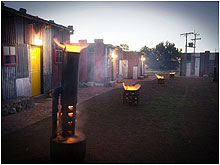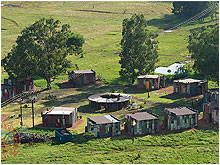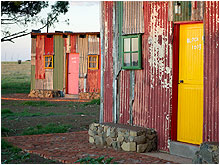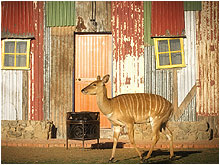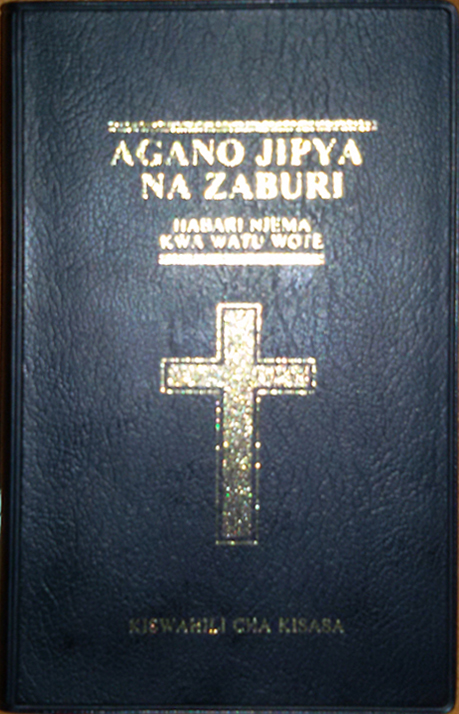The White Shantytowns Of South Africa
KnowledgeNuts

“Do you think, because I am poor, obscure, plain
and little, I am soulless and heartless? You think wrong! I have as much
soul as you, and full as much heart!” —Charlotte Bronte, Jane Eyre
In A Nutshell
South Africa has long been plagued by poverty. Across the nation, millions of citizens are forced to live in shantytowns and decrepit slums, a hangover from the enforced inequalities of the apartheid era. But while the majority of South Africa’s poor are black people, a completely new class has emerged since the seismic social shifts of 1994—formerly well-off white people who now eke out an existence in grinding poverty.
The Whole Bushel
When Nelson Mandela was elected president of South Africa in 1994, there was widespread hope that his government would wash away the extreme poverty and despair faced by millions of his countrymen. Unfortunately, a huge percentage of black South Africans continue to live below the breadline—only now they’re being joined by their white neighbors, too. It’s estimated that around 100,000 Afrikaners (descended from Dutch settlers) are currently camped out in shantytowns, trapped in dire poverty.
One of the most infamous of these is Coronation Park. In 1994, it was a getaway spot for wealthy whites wishing to escape the city. Today it’s a decaying slum: a wasteland of unemployment, malnutrition, and hopelessness. Families live in tents or broken shacks and rely on food hand-outs to survive. Drugs are a problem and the massive inequalities have given rise to an undercurrent of extreme racism in some parts of the park.
Although not as numerous as the country’s infamous townships, dozens of white camps like Coronation Park now exist across the country, each with their own unsolvable problems. Prior to the end of apartheid, South Africa had a system of guaranteed jobs, housing, and subsides for poor white citizens. With the end of minority rule, maintaining these subsidies became both immoral and logistically impossible. The result was a growing number of whites with no jobs, no backup, and no safety net. In 2008, then-presidential candidate Jacob Zuma visited another settlement at Bethlehem and expressed astonishment at the sheer number of whites living below the breadline.
Now, obviously these settlements need to be seen in a historical context. The number of black South Africans living in similarly impoverished conditions is huge, with the added downside that they were just as poor prior to 1994. That whites are now also penniless is an unfortunate side effect of bringing equality to millions.
Show Me The Proof
BBC News: South Africa’s hidden white poverty
Reuters: White poverty in South Africa (photo slideshow)
Radio Times: Reggie Yates on Extreme South Africa
Apartheid Shanty Towns in Cape Town
Capetown.at
| Shanty Towns | |
|---|---|
| During the fifties, the
government replaced 2,000 African employees in the Western Cape with coloured
and white workers, and pass laws were enforced by police trying to catch
'illegal' immigrant workers. However, the fast growing shanty towns on the edge
of Cape Town were evidence that influx control was not really working.
In the early fifties, the necessity to supply alternative accommodation stopped the local authorities from destroying shacks. Central government's reaction was to impose 'The Prevention of Illegal Squatting Act' in 1952 which forced local authorities to set up 'emergency camps' where shanty dwellers could be 'concentrated and controlled', and permitted authorities to destroy 'illegal' shacks. In the late 1950s the destruction of shack settlements increased in areas as diverse as Hout Bay and Elsies River. Over 5000 so-called 'bachelors' were forced to move into hostels, and thousands of 'illegals' - most of whom were women - were 'endorsed out' of the city. In 1959, despite vocal protest from many employers, the Native Affairs Department decreed that no more Africans could be employed for work in Cape Town. At the same time, the conditions in the Eastern Cape reserves were deteriorating and therefore migrant labour became a more significant lifeline for many families. The clearance of squatter camps continued throughout the sixties and seventies. The Modderdam squatter camp was destroyed by two bulldozers during one week in August 1977, and as residents watched their homes being razed they chanted freedom songs and hymns, charged policemen and threw furniture onto the road. Some even set fire to their own shacks before the authorities could reach them. |
|
| Crossroads | |
| In the 1970s a shanty town
developed at 'Crossroads', near the airport. It began when workers were told to
leave a white farm and move to 'the crossroads'. Finding only bush, they built
shacks and established a community that afforded families more scope for
creating individual, respectable homes than the hostels of Guguletu.
As Crossroads was considered a temporary camp by the authorities, eviction orders were made in 1975. However, these were not enforced because a Men's Committee and a Women's Committee had formed in order to fight this decision, the latter of the two being particularly successful at gaining support from within and outside the community. In 1977 a survey showed a total of 18,000 living at Crossroads. The Black Sash began to support the 'Save Crossroads' campaign, and in 1978 it was declared an 'emergency camp' thereby obliging the Council to supply water taps and remove refuse for a small fee. The battle to save Crossroads from destruction became a major battle of will between the government and the opposition movements during the late 1970s and 1980s. However, tensions rose within the shanty town and violence erupted around the schism between supporters of Johnson Ngxobongwana as head of the residents committee, and those who contested his behaviour of favouritism and reward to his henchmen. In 1983 there were bloody fights in Crossroads that spread into the nearby areas of KTC and Nyanga. A group of older Crossroads residents resented the rising influence of UDF supporters or 'comrades'. A group of these men, the 'witdoeke', wore white armbands and formed an alliance with the police to fight against these young 'comrades'. The 'witdoeke' were sanctioned to use weapons, and in the attacks on neighbouring townships and the setting fire to all the shanty settlements in old Crossroads, they caused an enormous amount of violence and rendered 60,000 people homeless. Some residents moved 'voluntarily' to a tented town near Site C in Khayelitsha to avoid the violence |
|
| Khayelitsha | |
| Meaning 'new home',
Khayelitsha was intended by the government to provide housing to all 'legal'
residents of the Cape Peninsula, whether they were in squatter camps or in
existing townships, in one purpose built and easily controlled township.
The plan was to create 4 towns, each with 30,000 residents in brick houses, a proportion of which were to be privately owned. Settlement began with a tented town - rows and rows of tents, to which Crossroads residents fled. By 1986 over 8,000 people lived in 4,150 'site and service' plots at Site C (site and service means demarcated plots, each with a tap and toilet), and a further 13,000 rented core houses in Town 1 (a core house is a small cement-brick structure that can be extended into a larger house). Yet, by 1990 the population of Khayelitsha was 450,000 and unemployment stood at 80%. Only 14% lived in core housing, with 54% in serviced shacks and 32% in unserviced areas. A handful of residents had electricity and most families had to fetch water from public taps. In conditions of overcrowding and lawlessness, unofficial councils elected by community members maintained social control in the neighbourhood, and enforced physical punishment upon adults and children who broke the local codes of behaviour. Khayelitsha grew rapidly during the 1990s as migrants from the Eastern Cape, previously deterred by influx control, arrived to look for work. By 1995 there were over half a million people living in Khayelitsha. Many brought their cattle and were able to earn an income by selling milk to township residents. The sight of cows crossing bridges over the N2 freeway reminds Capetonians of the strong rural connection of many of the city's residents. Fire was a constant hazard until electricity was made accessible as residents used paraffin and candles for cooking and light. Winds blowing across the flats spread fires quickly, destroying many crowded homes. Rates of domestic violence, rape, child abuse and murder increased dramatically during the 1990s on the Cape Flats. Police presence was minimal and in this climate, vigilante activities grew. Taxi wars were another feature of the early-mid 1990s as associations of drivers fought to control the lucrative routes between the Cape Flats and the centre and suburbs. Passengers were not only at risk of being caught up in violent clashes and the work of 'hit squads', but were also frequently endangered by dangerous driving as drivers tried to make more money by rushing along their routes. Slowly, however, developments began to transform the shanty towns into suburbs, although progress was slow (see the New South Africa). The open areas toward the False Bay coast were developed as 'site and service' plots in the mid-90s, such as Harare and Makhasa. Later a vast area beyond Harare was developed consisting of of tiny homes in long rows. The railway line was only extended to these areas in 2008. By this time the population of Khayelitsha was said to be over one million, although accurate data was lacking. There was still no hospital in teh entire area and other services, including policing, were - at best - controversial. Steven Otter wrote a very readable book about his stay in Khayelitsha in the early 2000s called 'Umlungu in Khayelitsha'. |
See also
Shanty Town - Emoya Hotel & Spa (!!!)
From here
Shanty Town for a unique accommodation experience in Bloemfontein
Millions
of people are living in informal settlements across South Africa. These
settlements consist of thousands of houses also referred to as Shacks,
Shantys or Makhukhus. A Shanty usually consists of old corrugated iron
sheets or any other waterproof material which is constructed in such a
way to form a small "house" or shelter where they make a normal living. A
paraffin lamp, candles, a battery operated radio, an outside toilet
(also referred to as a long drop) and a drum where they make fire for
cooking is normally part of this lifestyle.
Now you can experience staying in a Shanty within
the safe environment of a private game reserve. This is the only Shanty
Town in the world equipped with wireless internet access!
The Shanty Town is ideal for team building, braais,
fancy theme parties and an experience of a lifetime. Accommodates up to
52 guests. Our Shantys are completely safe and child friendly.
This is an experience you will never forget!
Shanty Town offers the following:
Click the play button below for a quick glimpse into what the Shanty Town has to offer. Click the Full Screen button (below right) for a more detailed view.
Please
note that Emoya Spa and Oopvuur Restaurant are operated separately and
is billed separately from Emoya Basotho Village and Shanty Town
See also
Shanty town in the World The shantytowns of Kibera & Mathare in Kenya | |
|
